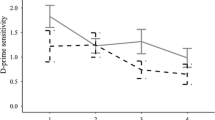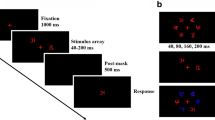Abstract
The present study investigated the associations of visual-spatial attention with word reading fluency and spelling in 92 third grade Hong Kong Chinese children. Word reading fluency was measured with a timed reading task whereas spelling was measured with a dictation task. Results showed that visual-spatial attention was a unique predictor of speeded reading accuracy (i.e., the total number of words read correctly divided by the total number of words read in a timed reading task) but not reading speed (i.e., the number of words read correctly in the same task) after controlling for age, non-verbal intelligence, morphological awareness, phonological awareness, orthographic knowledge, and rapid automatized naming. Visual-spatial attention also explained unique variance in word spelling measured with a dictation task after the same control variables. The findings of the present study suggest that visual-spatial attention is important for literacy development in Chinese children.
Similar content being viewed by others
Notes
Traditional Chinese is currently used in Taiwan and Hong Kong. Traditional characters have more strokes on average than simplified characters, which are currently used in Mainland China and Singapore.
Perimetric complexity is calculated by the squared perimeter of the stimulus divided by its ink area. The ink area is measured with the number of inked pixels on the computer screen times the area of a pixel.
References
Casco, C., Tressoldi, P. E., & Dellantonio, A. (1998). Visual selective attention and reading efficiency are related in children. Cortex, 34, 531–546. doi:10.1016/S0010-9452(08)70512-4.
Cheung, H., & Ng, L. K. H. (2003). Chinese reading development in some major Chinese societies: An introduction. In C. McBride-Chang & H.-C. Chen (Eds.), Reading development in Chinese children (pp. 3–18). Westport, CT: Greewood.
Ehri, L. C. (1980). The role of orthographic images in learning printed words. In J. F. Kavanaugh & R. L. Venezky (Eds.), Orthography, reading, and dyslexia (pp. 155–170). Baltimore, MD: University Park Press.
Facoetti, A., Paganoni, P., Turatto, M., Marzola, V., & Mascetti, G. G. (2000). Visual-spatial attention in developmental dyslexia. Cortex, 36, 109–123. doi:10.1016/S0010-9452(08)70840-2.
Ferretti, G., Mazzotti, S., & Brizzolara, D. (2008). Visual scanning and reading ability in normal and dyslexic children. Behavioural Neurology, 19, 87–92. doi:10.1155/2008/564561.
Franceschini, S., Gori, S., Ruffino, M., Pedrolli, K., & Facoetti, A. (2012). A causal link between visual spatial attention and reading acquisition. Current Biology, 22, 814–819. doi:10.1016/j.cub.2012.03.013.
Georgiou, G. K., Parrila, R., Cui, Y., & Papadopoulos, T. C. (2013). Why is rapid automatized naming related to reading? Journal of Experimental Child Psychology, 115, 218–225. doi:10.1016/j.jecp.2012.10.015.
Ho, C. S., & Bryant, P. (1999). Different visual skills are important in learning to read English and Chinese. Educational and Child Psychology, 16, 4–14.
Ho, C. S., Chan, D. W., Tsang, S., & Lee, S. (2002). The cognitive profile and multiple-deficit hypothesis in Chinese developmental dyslexia. Developmental Psychology, 38, 543–553. doi:10.1037/0012-1649.38.4.543.
Huang, H. S., & Hanley, J. R. (1995). Phonological awareness and visual skills in learning to read Chinese and English. Cognition, 54, 73–98. doi:10.1016/0010-0277(94)00641-W.
Lervåg, A., & Hulme, C. (2009). Rapid automatized naming (RAN) taps a mechanism that places constraints on the development of early reading fluency. Psychological Science, 20, 1040–1048. doi:10.1111/j.1467-9280.2009.02405.x.
Liao, C. H., Deng, C., Hamilton, J., Lee, C. S., Wei, W., & Georgiou, G. K. (2015). The role of rapid naming in reading development and dyslexia in Chinese. Journal of Experimental Child Psychology, 130, 106–122. doi:10.1016/j.jecp.2014.10.002.
Liu, D., Chen, X., & Chung, K. K. H. (2015). Performance in a visual search task uniquely predicts reading abilities in third-grade Hong Kong Chinese children. Scientific Studies of Reading, 19, 307–324. doi:10.1080/10888438.2015.1030749.
Liu, P. D., & McBride-Chang, C. (2010). What is morphological awareness? Tapping lexical compounding awareness in Chinese third graders. Journal of Educational Psychology, 102, 62–73. doi:10.1037/a0016933.
Luo, Y., Chen, X., Deacon, H., Zhang, J., & Yin, L. (2013). The role of visual processing in learning to read Chinese characters. Scientific Studies of Reading, 17, 22–40. doi:10.1080/10888438.2012.689790.
Mcbride-Chang, C., Chow, B. W. Y., Zhong, Y., Burgess, S., & Hayward, W. G. (2005). Chinese character acquisition and visual skills in two Chinese scripts. Reading and Writing, 18, 99–128. doi:10.1007/s11145-004-7343-5.
McBride-Chang, C., & Kail, R. V. (2002). Cross-cultural similarities in the predictors of reading acquisition. Child Development, 73, 1392–1407. doi:10.1111/1467-8624.00479.
McBride-Chang, C., Shu, H., Zhou, A., Wat, C. P., & Wagner, R. K. (2003). Morphological awareness uniquely predicts young children’s Chinese character recognition. Journal of Educational Psychology, 95, 743–751. doi:10.1037/0022-0663.95.4.743.
Moll, K., Fussenegger, B., Willburger, E., & Landerl, K. (2009). RAN is not a measure of orthographic processing. Evidence from the asymmetric German orthography. Scientific Studies of Reading, 13, 1–25. doi:10.1080/10888430802631684.
Pammer, K., Lavis, R., Hansen, P., & Cornelissen, P. L. (2004). Symbol-string sensitivity and children’s reading. Brain and Language, 89, 601–610. doi:10.1016/j.bandl.2004.01.009.
Pasquarella, A., Chen, X., Gottardo, A., & Geva, E. (2015). Cross-language transfer of word reading accuracy and word reading fluency in Spanish–English and Chinese–English bilinguals: Script-universal and script-specific processes. Journal of Educational Psychology, 107, 96–110. doi:10.1037/a0036966.
Pelli, D. G., Burns, C. W., Farell, B., & Moore-Page, D. C. (2006). Feature detection and letter identification. Vision Research, 46, 4646–4674. doi:10.1016/j.visres.2006.04.023.
Plaza, M., & Cohen, H. (2007). The contribution of phonological awareness and visual attention in early reading and spelling. Dyslexia, 13, 67–76. doi:10.1002/dys.330.
Semrud-Clikeman, M., Guy, K., Girffin, J. D., & Hynd, G. W. (2000). Rapid naming deficits in children and adolescents with reading disabilities and attention deficit hyperactivity disorder. Brain and Language, 74, 70–83. doi:10.1006/brln.2000.2337.
Shu, H., Peng, H., & McBride-Chang, C. (2008). Phonological awareness in young Chinese children. Developmental Science, 11, 171–181. doi:10.1111/j.1467-7687.2007.00654.x.
Tong, X., McBride-Chang, C., Shu, H., & Wong, A. M. Y. (2009). Morphological awareness, orthographic knowledge, and spelling errors: Keys to understanding early Chinese literacy acquisition. Scientific Studies of Reading, 13, 426–452. doi:10.1080/10888430903162910.
Tzeng, O. J. L., & Wang, W. S.-Y. (1983). The first two R’s: The way different languages reduce speech to script affects how visual information is processed in the brain. American Scientist, 71, 238–243.
Vaessen, A., & Blomert, L. (2010). Long-term cognitive dynamics of fluent reading development. Journal of Experimental Child Psychology, 105, 213–231. doi:10.1016/j.jecp.2009.11.005.
Vaessen, A., Gerretsen, P., & Blomert, L. (2009). Naming problems do not reflect a second independent core deficit in dyslexia: Double deficits explored. Journal of Experimental Child Psychology, 103, 202–221. doi:10.1016/j.jecp.2008.12.004.
Vecera, S. P., & Rizzo, M. (2003). Spatial attention: Normal processes and their breakdown. Neurologic Clinics of North America, 21, 575–607. doi:10.1016/S0733-8619(02)00103-2.
Vidyasagar, T. R., & Pammer, K. (2010). Dyslexia: A deficit in visuo-spatial attention, not in phonological processing. Trends in Cognitive Sciences, 14, 57–63. doi:10.1016/j.tics.2009.12.003.
Wang, J., Bi, H., Gao, L., & Wydell, T. N. (2010). The visual magnocellular pathway in Chinese-speaking children with developmental dyslexia. Neuropsychologia, 48, 3627–3633. doi:10.3389/fpsyg.2014.00692.
Wang, Y., McBride-Chang, C., & Chan, S. F. (2014). Correlates of Chinese kindergartenders’ word reading and writing: The unique role of copying skills? Reading and Writing, 27, 1281–1302. doi:10.1007/s11145-013-9486-8.
Wong, A. C. N., Bukach, C. M., Yuen, C., Yang, L., Leung, S., & Greenspon, E. (2011). Holistic processing of words modulated by reading experience. PLoS ONE, 6, e20753. doi:10.1371/journal.pone.0020753.
Acknowledgments
This study was supported by the General Research Fund of the Hong Kong Special Administrative Region Research Grants Council (HKIED: GRF/ECS 858113). We thank all the children, their parents and teachers, for their participation.
Author information
Authors and Affiliations
Corresponding author
Rights and permissions
About this article
Cite this article
Liu, D., Chen, X. & Wang, Y. The impact of visual-spatial attention on reading and spelling in Chinese children. Read Writ 29, 1435–1447 (2016). https://doi.org/10.1007/s11145-016-9644-x
Published:
Issue Date:
DOI: https://doi.org/10.1007/s11145-016-9644-x




